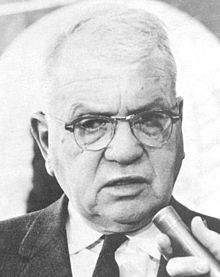Harold Urey

Harold Clayton Urey (April 29, 1893 – January 5, 1981) was a chemist whose pioneering work on isotopes earned him the Nobel Prize in Chemistry in 1934 and later led him to theories of planetary evolution.
Biography
Urey was born in Walkerton, Indiana. After briefly teaching in rural schools, Urey earned a degree in zoology from the University of Montana and a Ph.D. in chemistry, studying thermodynamics under Gilbert N. Lewis at the University of California, Berkeley.
At Berkeley, Urey was influenced by the work of physicist Raymond T. Birge and soon joined Niels Bohr in Copenhagen to work on atomic structure at the Institute for Theoretical Physics. On his return to the US in 1924 he taught at Johns Hopkins University, and then at Columbia where he assembled a team of associates that included Rudolph Schoenheimer, David Rittenberg and T. I. Taylor. After completion of his text with Arthur Ruark, Atoms, Quanta and Molecules, one of the first English texts on quantum mechanics and its applications to atomic and molecular systems, Urey became interested in nuclear systematics. This led to his discovery of deuterium.
During this time, Urey isolated deuterium by repeatedly distilling a sample of liquid hydrogen. In 1931, he and his associates went on to demonstrate the existence of heavy water. Urey was awarded the Nobel Prize in Chemistry in 1934 for this work.
During World War II, Urey's team at Columbia worked on a number of research programs that contributed towards the Manhattan Project to develop an atomic bomb for the United States. Most importantly, they developed the gaseous diffusion method to separate uranium-235 from uranium-238. In autumn 1941, Urey, with G. B. Pegram, led a diplomatic mission to England to establishing co-operation on development of the atomic bomb.
After the war, he became professor of chemistry at the Institute for Nuclear Studies, then Ryerson professor of chemistry at the University of Chicago before progressing to honorific offices at the University of California, San Diego.
In later life, Urey helped develop the field of cosmochemistry and is credited with coining the term. His work on oxygen-18 led him to develop theories about the abundance of the chemical elements on earth and of their abundance and evolution in the stars. Urey summarised his work in the book The Planets: Their Origin and Development (1952). Urey speculated that the early terrestrial atmosphere was probably composed of ammonia, methane and hydrogen; it was one of his Chicago graduate students, Stanley L. Miller, who showed that, if such a mixture be exposed to ultraviolet radiation and to water, it can interact to produce amino acids, commonly called the "building blocks of life" (see Miller-Urey experiment).
Urey died at La Jolla, California, and is buried in the Fairfield Cemetery in DeKalb County, Indiana.
Apart from his Nobel Prize, he also won the Gold Medal of the Royal Astronomical Society in 1966. Named after him are lunar impact crater Urey, asteroid 4716 Urey and the H. C. Urey Prize, awarded for achievement in planetary sciences by the American Astronomical Society.
External links
There is now a school in Walkerton, IN, named Harold C. Urey Middle School.
